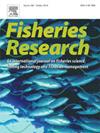探索在努力有限的渔业中引入替代渔具的后果:卡西塔在佛罗里达州多刺龙虾中的利用
IF 2.2
2区 农林科学
Q2 FISHERIES
引用次数: 0
摘要
21世纪初,随着被称为“casitas”的人工避难所的扩大使用,佛罗里达州潜水员对龙虾的商业捕捞有所增加。卡西塔是佛罗里达州的一种非法渔具,这使得渔具数量和登陆量的激增难以评估。这导致商业龙虾潜水员和商业捕虾器渔民之间的冲突加剧,他们争夺同一资源,并促使需要重新评估商业潜水渔业的捕捞能力和收获潜力。为了应对将渔具引入龙虾渔业,我们评估了渔具类型对捕捞量的影响,以及渔具抗陷阱的性能,并探讨了将新渔具引入现有的、已经资本过剩的渔业的潜在警告和后果。总的来说,casita的使用增加了对潜水员的实际分配。在卡西塔使用增加的年份,陷阱渔民的陷阱捕获量下降,但这一时期也与所有部门的年度捕获量低的时期重叠,这可能加剧了潜水员是陷阱部门捕获量低的原因的看法。实地研究表明,在整个捕捞季节,每个小屋平均捕获81.4 ± 10.6 公斤龙虾,是单个捕虾器平均捕虾量的17倍。80%的龙虾捕获量(公斤龙虾)发生在捕捞季的头四周,之后捕获量急剧下降。虽然小屋似乎比陷阱有更多的初始捕获量和更低的丢弃死亡率,但目前尚不清楚是否可以在整个捕鱼季节有效地利用小屋来维持当前的捕鱼量。将卡西塔作为管制渔具纳入佛罗里达州龙虾渔业的主要障碍是:以陷阱为主的既定渔业社会和经济结构受到破坏;执法方面的后勤挑战;在主要收获的佛罗里达群岛国家海洋保护区禁止使用卡西塔;以及在努力有限的渔业中增加捕捞努力的障碍。本文章由计算机程序翻译,如有差异,请以英文原文为准。
Exploring the consequences of introducing alternative fishing gear in an effort-limited fishery: Casita utilization in the spiny lobster, Panulirus argus, fishery in Florida
Commercial harvest of spiny lobsters in Florida by divers increased in the early 2000s with the expanded utilization of artificial shelters called “casitas.” Casitas were an illegal fishing gear in Florida, making the proliferation of the amount of gear and landings difficult to assess. This led to an intensifying conflict between commercial lobster divers and commercial lobster trap fishers, who were competing for the same resource and prompted the need for a reassessment of the fishing capacity and harvest potential for the commercial dive fishery. In response to the introduction of casitas to the lobster fishery, we evaluated the effect on landings by gear type, the performance of casitas against traps and explored the potential caveats and consequences of introducing new fishing gear into an existing, already overcapitalized fishery. Overall, casita use increased the de facto allocation of landings to divers. Trap fishers experienced a decline in trap catch during years with increased casita use, but this time period also overlapped with a period of low annual landings for all sectors and likely intensified the perception that divers were the cause of low landings in the trap sector. Field studies indicated an average of 81.4 ± 10.6 kg of lobster per casita were harvested over the course of the fishing season, or 17 times more than the average for a single trap. Eighty percent of catch (kg of lobster) from casitas occurred during the first four weeks of the season, after which catch dropped precipitously. While casitas appear to have greater initial catch and lower discard mortality than traps, it remains unclear if casitas could be used efficiently throughout the duration of the fishing season to maintain the current harvest in the fishery. The major impediments to inclusion of casitas as a regulated gear in the lobster fishery in Florida are disruption of the established social and economic structure of the fishery that is dominated by traps, logistical challenges to enforcement, prohibitions on casita use in the Florida Keys National Marine Sanctuary where the majority of harvest takes place, and hurdles to add to fishing effort in an effort-limited fishery.
求助全文
通过发布文献求助,成功后即可免费获取论文全文。
去求助
来源期刊

Fisheries Research
农林科学-渔业
CiteScore
4.50
自引率
16.70%
发文量
294
审稿时长
15 weeks
期刊介绍:
This journal provides an international forum for the publication of papers in the areas of fisheries science, fishing technology, fisheries management and relevant socio-economics. The scope covers fisheries in salt, brackish and freshwater systems, and all aspects of associated ecology, environmental aspects of fisheries, and economics. Both theoretical and practical papers are acceptable, including laboratory and field experimental studies relevant to fisheries. Papers on the conservation of exploitable living resources are welcome. Review and Viewpoint articles are also published. As the specified areas inevitably impinge on and interrelate with each other, the approach of the journal is multidisciplinary, and authors are encouraged to emphasise the relevance of their own work to that of other disciplines. The journal is intended for fisheries scientists, biological oceanographers, gear technologists, economists, managers, administrators, policy makers and legislators.
 求助内容:
求助内容: 应助结果提醒方式:
应助结果提醒方式:


